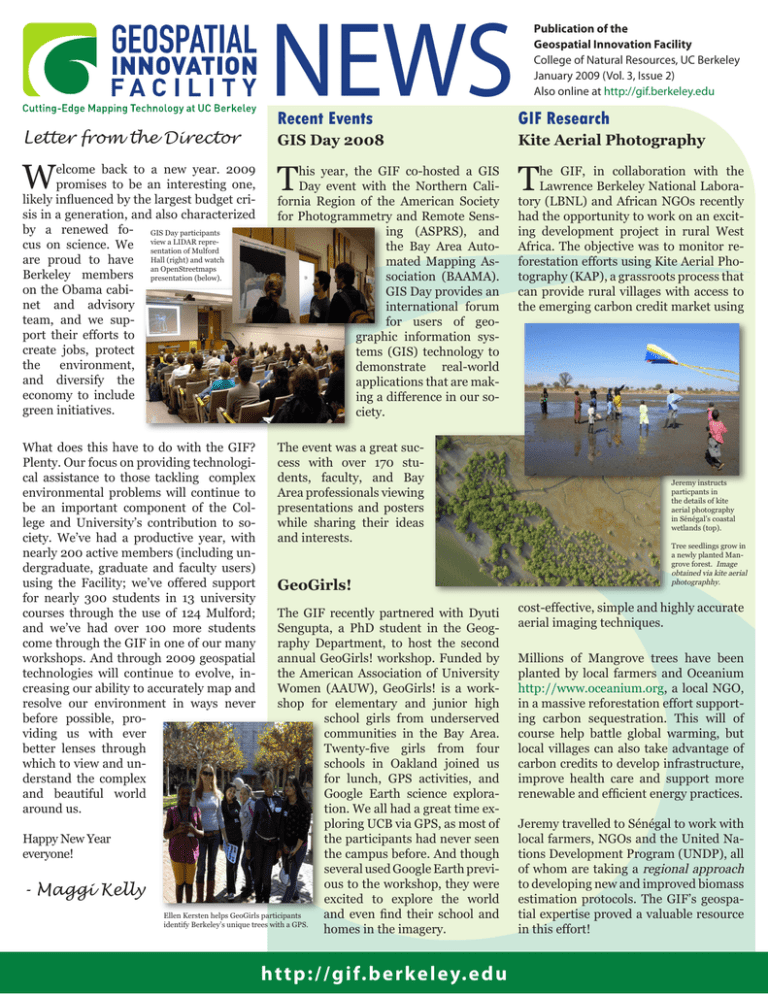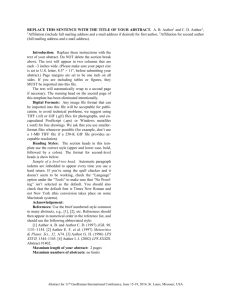http://gif.berkeley.edu - Geospatial Innovation Facility
advertisement

NEWS Publication of the Geospatial Innovation Facility College of Natural Resources, UC Berkeley January 2009 (Vol. 3, Issue 2) Also online at http://gif.berkeley.edu Recent Events GIF Research GIS Day 2008 Kite Aerial Photography W elcome back to a new year. 2009 promises to be an interesting one, likely influenced by the largest budget crisis in a generation, and also characterized by a renewed fo- GIS Day participants a LIDAR reprecus on science. We view sentation of Mulford are proud to have Hall (right) and watch an OpenStreetmaps Berkeley members presentation (below). on the Obama cabinet and advisory team, and we support their efforts to create jobs, protect the environment, and diversify the economy to include green initiatives. T T What does this have to do with the GIF? Plenty. Our focus on providing technological assistance to those tackling complex environmental problems will continue to be an important component of the College and University’s contribution to society. We’ve had a productive year, with nearly 200 active members (including undergraduate, graduate and faculty users) using the Facility; we’ve offered support for nearly 300 students in 13 university courses through the use of 124 Mulford; and we’ve had over 100 more students come through the GIF in one of our many workshops. And through 2009 geospatial technologies will continue to evolve, increasing our ability to accurately map and resolve our environment in ways never before possible, providing us with ever better lenses through which to view and understand the complex and beautiful world around us. The event was a great success with over 170 students, faculty, and Bay Area professionals viewing presentations and posters while sharing their ideas and interests. Letter from the Director Happy New Year everyone! - Maggi Kelly his year, the GIF co-hosted a GIS Day event with the Northern California Region of the American Society for Photogrammetry and Remote Sensing (ASPRS), and the Bay Area Automated Mapping Association (BAAMA). GIS Day provides an international forum for users of geographic information systems (GIS) technology to demonstrate real-world applications that are making a difference in our society. GeoGirls! The GIF recently partnered with Dyuti Sengupta, a PhD student in the Geography Department, to host the second annual GeoGirls! workshop. Funded by the American Association of University Women (AAUW), GeoGirls! is a workshop for elementary and junior high school girls from underserved communities in the Bay Area. Twenty-five girls from four schools in Oakland joined us for lunch, GPS activities, and Google Earth science exploration. We all had a great time exploring UCB via GPS, as most of the participants had never seen the campus before. And though several used Google Earth previous to the workshop, they were excited to explore the world and even find their school and Ellen Kersten helps GeoGirls participants identify Berkeley’s unique trees with a GPS. homes in the imagery. http://gif.b erkeley.edu he GIF, in collaboration with the Lawrence Berkeley National Laboratory (LBNL) and African NGOs recently had the opportunity to work on an exciting development project in rural West Africa. The objective was to monitor reforestation efforts using Kite Aerial Photography (KAP), a grassroots process that can provide rural villages with access to the emerging carbon credit market using Jeremy instructs particpants in the details of kite aerial photography in Sénégal’s coastal wetlands (top). Tree seedlings grow in a newly planted Mangrove forest. Image obtained via kite aerial photographhy. cost-effective, simple and highly accurate aerial imaging techniques. Millions of Mangrove trees have been planted by local farmers and Oceanium http://www.oceanium.org, a local NGO, in a massive reforestation effort supporting carbon sequestration. This will of course help battle global warming, but local villages can also take advantage of carbon credits to develop infrastructure, improve health care and support more renewable and efficient energy practices. Jeremy travelled to Sénégal to work with local farmers, NGOs and the United Nations Development Program (UNDP), all of whom are taking a regional approach to developing new and improved biomass estimation protocols. The GIF’s geospatial expertise proved a valuable resource in this effort! Upcoming Events Cal Student Research Urban growth in the Nile Delta ASPRS Technical Session Workshops & Seminars What do you do when you can’t find any data for your study area? You make your own data! CNR student Anna Spurlock has been doing just that. Anna is interested in whether or not the availability of water in the Nile Delta region can explain recent patterns of growth in urban areas. Please join us Wednesday, Feb. 25, 5:308:00PM for a geospatial technical presentation sponsored by the Northern California Region of the American Society for Photogrammetry & Remote Sensing (ASPRS). ASPRS is a national scientific association of over 7,000 members, dedicated to advancing the knowledge and understanding of mapping sciences. This is a great opportunity to meet Bay Area professionals and learn about current research projects that utilize geospatial technology. The Spring 2009 workshop agenda is now available at: http://gif.berkeley.edu. Be sure to check out all of the different geospatial courses being offered in: • Intro to GIS • Intro to GPS • Intro to Remote Sensing • Land cover change analysis • Object-based image analysis • Creating a WebGIS with Google Maps • Intro to Species Distribution Modeling After attending the GIF’s series of Remote Free Landsat! Sensing workshops, she believes that she Do you enjoy looking at imagery on Google can answer this quesEarth? Come to our Intro to Remote Senstion by comparing Beginning at 5:30 we will host ing workshop to find out how you can Landsat satellite imagan hour of refreshments and download, explore, and analyze satellite ery between two dates networking in the GIF (Mul- imagery from a variety of sources all over (1984 - 2002) in orford 111) followed the world. der to identify areas of by presentations change, while examinand discussion As of this month (1/09), ing how the areas ex(6:30-8:00) in the USGS has released hibiting greater urban the Genetics & it’s entire archive of growth relate to availPlant Biology Landsat imagery for free able water supplies. Landcover change seen via free Landsat imag- (GPB) Building download! With thouAnna’s hard work will ery over the Nile Delta area. In this example room 100. Stay sands of available imimagery, Anna is able to compare an image not only help to answer from 1990 (top) with an image from 2000 tuned to our ages starting in 1972, it to determine urban growth (bottom) her question, the data (center) website for up to is now easier than ever as seen in yellow. that she creates will date information to analyze how the world Bay Area visible through Landsat. In this help to enrich an area where accurate land on the session’s speakers. has changed over the last enhanced false color composite view, vegetation in the hills can be seen in green, urban areas in cover data is difficult to find. three decades. purple, and water in blue. GIF WebGIS Oakmapper 2.0 The Kelly Research Lab, with support from the GIF, has released a new Oakmapper (http://oakmapper.org), designed to aid in mapping areas of oak mortality around the state. Be sure to visit the site and sign up to be a user! GeoLunch Thank you so much to the 12 wonderful speakers that joined us for GeoLunch last term! From the amazing developments of Spatial R to the latest in Google Maps technology, we were treated to an amazing assortment of geospatial topics. We are excited to be collaborating with UC Berkeley’s Museum of Vertebrate Zoology (MVZ) this term to bring you another great series of presentations and discussions. The GeoLunch schedule is available at: http://gif.berkeley.edu/about/geolunch.html GIF on Facebook Keep up to date on events, and connect with others in the GIF community, we are now on Facebook! Listed under “Geospatial Innovation Facility - UC Berkeley” become a fan today and meet others with an interest in geospatial technology. http://gif.b erkeley.edu During a series of three workshops, we will explore the basics of understanding digital multispectral imagery, perform landcover classification mapping, and compare multiple images to study land cover change. GIF Staff Kevin and Jeremy are available for support and training. Please stop by our office hours to learn how you can use geospatial technology in your research! Kevin Koy Manager kkoy@nature.berkeley.edu Office Hours: M, W, 2-4pm Jeremy Freund Geospatial IT Specialist jfreund@nature.berkeley.edu Office Hours: T, Th, 2-4pm



